Fluoride Removal Using Nanofiltration-Ranged Polyamide Thin-Film Nanocomposite Membrane Incorporated Titanium Oxide Nanosheets
Abstract
1. Introduction
2. Experimental
2.1. Materials and Chemicals
2.2. Fabrication of Polysulfone Support Layer
2.3. Preparation of Thin Film Nanocomposite Membrane
2.4. Membrane Characterizations
2.5. TFN Membranes’ Performance Analysis
3. Theoretical Modelling Background
3.1. Donnan Steric Pore Model with the Dielectric Exclusion
3.2. The Supply–Demand-Based Optimization Algorithm
3.3. Procedure to Estimate the Parameters
4. Results and Discussion
4.1. Membrane Characterization
4.1.1. Surface Morphology
4.1.2. Interaction between TiO2 NSs and Polymer
4.1.3. Surface Properties
Zeta Potential
Water Contact Angle
4.2. Membrane Performance
4.2.1. Salt Rejection
4.2.2. Fluoride Rejection
Amount of Incorporated TiO2
Initial Concentration
pH of Fluoride Solution
4.3. Fluoride Removal Efficiency
4.4. Donnan-Steric-Pore-Model-Dielectric-Exclusion Model
5. Conclusions
Supplementary Materials
Author Contributions
Funding
Data Availability Statement
Conflicts of Interest
Nomenclature
| A | The effective area of the membrane (m2) |
| ion (i) concentration within a pore (mol m−3) | |
| concentration of solute (mol m−3) | |
| solute concentration in feed (mol m−3) | |
| solute concentration in permeate (mol m−3) | |
| coefficient of diffusion in the pore | |
| hindered diffusivity | |
| diffusion coefficient of species i in water (at an infinite dilution) | |
| Faraday constant value (96,487 C mol−1) | |
| flux of permeate (Lm−2 h−1) | |
| mole flux of the solute (mol/m2/s) | |
| volume flux (m3 m−2 s−1) | |
| the coefficient of hindrance for convection | |
| The coefficient of hindrance for diffusion | |
| n | number of markets |
| N | number of data that has been tested |
| P | applied pressure (bar) |
| gas constant (8.314 J mol−1 K−1) | |
| radius of solute | |
| the radius of effective pore | |
| experimental rejection | |
| rejection obtained model | |
| volume of permeated water (L) | |
| valence of ion i, dimensionless | |
| T | temperature (K) |
| Xd | effective charge of the membrane |
| Greek letters | |
| permeation time (h) | |
| Donnan potential (V) | |
| Pore dielectric constant | |
| the ratio of the radius of solute to the radius of effective pore, dimensionless | |
| The feed’s ionic conductivity | |
| The permeate’s conductivity | |
| osmotic pressure difference | |
| dimensionless steric partition coefficient | |
| electric potential (V) | |
| permeation time (h) | |
| Donnan potential (V) | |
References
- Fawell, J.; Bailey, K.; Chilton, J.; Dahi, E.; Fewtrell, L.; Magara, Y. Flouride in Drinking-Water; IWA Publishing: London, UK, 2001; ISBN 9781900222969. [Google Scholar]
- Pontié, M.; Diawara, C.; Lhassani, A.; Dach, H.; Rumeau, M.; Buisson, H.; Schrotter, J.C. Chapter 2 Water Defluoridation Processes: A Review. Application: Nanofiltration (NF) for Future Large-Scale Pilot Plants. Adv. Fluor. Sci. 2006, 2, 49–80. [Google Scholar]
- Ayala, L.I.M.; Paquet, M.; Janowska, K.; Jamard, P.; Quist-Jensen, C.A.; Bosio, G.N.; Mártire, D.O.; Fabbri, D.; Boffa, V. Water Defluoridation: Nanofiltration vs Membrane Distillation. Ind. Eng. Chem. Res. 2018, 57, 14740–14748. [Google Scholar] [CrossRef]
- Ali, S.; Thakur, S.K.; Sarkar, A.; Shekhar, S. Worldwide Contamination of Water by Fluoride. Environ. Chem. Lett. 2016, 14, 291–315. [Google Scholar] [CrossRef]
- Anesthesia, N.; Be, S.; In, M.O.; In, L.; Appropriate, W.; Equipment, R.; Are, D.; Available, I.; Manage, T.O.; Ii, G.; et al. Guidelines for Drinking-Water Quality; WHO Chronicle: Geneva, Switzerland, 2010; ISBN 9789240045064. [Google Scholar]
- Çengeloglu, Y. Removal of Fluoride from Aqueous Solution by Using Red Mud. Sep. Purif. Technol. 2002, 28, 81–86. [Google Scholar] [CrossRef]
- Valentukeviciene, M.; Zurauskiene, R.; Boussouga, Y.A. Fluoride Removal from Groundwater by Technological Process Optimization. Ecol. Chem. Eng. S 2019, 26, 133–147. [Google Scholar] [CrossRef]
- Chakrabortty, S.; Roy, M.; Pal, P. Removal of Fluoride from Contaminated Groundwater by Cross Flow Nanofiltration: Transport Modeling and Economic Evaluation. Desalination 2013, 313, 115–124. [Google Scholar] [CrossRef]
- Ndiaye, P.I.; Moulin, P.; Dominguez, L.; Millet, J.C.; Charbit, F. Removal of Fluoride from Electronic Industrial Effluentby RO Membrane Separation. Desalination 2005, 173, 25–32. [Google Scholar] [CrossRef]
- Meenakshi, S.; Viswanathan, N. Identification of Selective Ion-Exchange Resin for Fluoride Sorption. J. Colloid Interface Sci. 2007, 308, 438–450. [Google Scholar] [CrossRef]
- Viswanathan, N.; Meenakshi, S. Role of Metal Ion Incorporation in Ion Exchange Resin on the Selectivity of Fluoride. J. Hazard. Mater. 2009, 162, 920–930. [Google Scholar] [CrossRef]
- Reardon, E.J.; Wang, Y. A Limestone Reactor for Fluoride Removal from Wastewaters. Environ. Sci. Technol. 2000, 34, 3247–3253. [Google Scholar] [CrossRef]
- Jadhav, S.V.; Bringas, E.; Yadav, G.D.; Rathod, V.K.; Ortiz, I.; Marathe, K.V. Arsenic and Fluoride Contaminated Groundwaters: A Review of Current Technologies for Contaminants Removal. J. Environ. Manag. 2015, 162, 306–325. [Google Scholar] [CrossRef] [PubMed]
- Mallya, D.S.; Dumée, L.F.; Muthukumaran, S.; Lei, W.; Baskaran, K. 2D Nanosheet Enabled Thin Film Nanocomposite Membranes for Freshwater Production—A Review. Mater. Adv. 2021, 2, 3519–3537. [Google Scholar] [CrossRef]
- Jhaveri, J.H.; Murthy, Z.V.P. A Comprehensive Review on Anti-Fouling Nanocomposite Membranes for Pressure Driven Membrane Separation Processes. Desalination 2016, 379, 137–154. [Google Scholar] [CrossRef]
- Safarpour, M.; Khataee, A.; Vatanpour, V. Thin Film Nanocomposite Reverse Osmosis Membrane Modified by Reduced Graphene Oxide/TiO2 with Improved Desalination Performance. J. Memb. Sci. 2015, 489, 43–54. [Google Scholar] [CrossRef]
- Sasaki, T.; Watanabe, M.; Hashizume, H.; Yamada, H.; Nakazawa, H. Macromolecule-like Aspects for a Colloidal Suspension of an Exfoliated Titanate. Pairwise Association of Nanosheets and Dynamic Reassembling Process Initiated from It. J. Am. Chem. Soc. 1996, 118, 8329–8335. [Google Scholar] [CrossRef]
- Xue, S.; Lin, C.W.; Ji, C.; Guo, Y.; Liu, L.; Yang, Z.; Zhao, S.; Cai, X.; Niu, Q.J.; Kaner, R.B. Thin-Film Composite Membranes with a Hybrid Dimensional Titania Interlayer for Ultrapermeable Nanofiltration. Nano Lett. 2022, 22, 1039–1046. [Google Scholar] [CrossRef] [PubMed]
- Ahmad, N.A.; Goh, P.S.; Wong, K.C.; Zulhairun, A.K.; Ismail, A.F. Enhancing Desalination Performance of Thin Film Composite Membrane through Layer by Layer Assembly of Oppositely Charged Titania Nanosheet. Desalination 2020, 476, 114167. [Google Scholar] [CrossRef]
- Ghaithan, H.M.; Qaid, S.M.; Hezam, M.; Siddique, M.B.; Idriss, M. Invoking the Frequency Dependence in Square Modulated Light Intensity Techniques for the Measurement of Electron Time Constants in Dye- Sensitized Solar Cells. In Proceedings of the Nanoengineering: Fabrication, Properties, Optics, and Devices XII, San Diego, CA, USA, 11–12 August 2015; Volume 9556, pp. 1–8. [Google Scholar] [CrossRef]
- Joselito, H.; Aldwayyan, P.L.A.S.; Bedja, I.M. Laser Induced Photocurrent and Photovoltage Transient Measurements of Dye-Sensitized Solar Cells Based on TiO2 Nanosheets and TiO2 Nanoparticles. Electrochim. Acta 2016, 212, 992–997. [Google Scholar] [CrossRef]
- Khorshidi, B.; Thundat, T.; Fleck, B.A.; Sadrzadeh, M. Thin Film Composite Polyamide Membranes: Parametric Study on the Influence of Synthesis Conditions. RSC Adv. 2015, 5, 54985–54997. [Google Scholar] [CrossRef]
- Ahmed Ali, F.A.; Alam, J.; Kumar Shukla, A.; Alhoshan, M.; Khaled, J.M.; Al-Masry, W.A.; Alharbi, N.S.; Alam, M. Graphene Oxide-Silver Nanosheet-Incorporated Polyamide Thin-Film Composite Membranes for Antifouling and Antibacterial Action against Escherichia Coli and Bovine Serum Albumin. J. Ind. Eng. Chem. 2019, 80, 227–238. [Google Scholar] [CrossRef]
- Bowen, W.R.; Mukhtar, H. Characterisation and Prediction of Separation Performance of Nanofiltration Membranes. J. Memb. Sci. 1996, 112, 263–274. [Google Scholar] [CrossRef]
- Abdulraqeb, F.; Ali, A.; Alam, J.; Kumar, A. Assessing the Properties of Thin-Film Nanocomposite Membrane Embedded with GO Nanosheets Using the DSPM-DE Model. J. Mater. Res. Technol. 2022, 19, 74–90. [Google Scholar] [CrossRef]
- Xia, S.; Yao, L.; Zhao, Y.; Li, N.; Zheng, Y. Preparation of Graphene Oxide Modified Polyamide Thin Film Composite Membranes with Improved Hydrophilicity for Natural Organic Matter Removal. Chem. Eng. J. 2015, 280, 720–727. [Google Scholar] [CrossRef]
- Shokrgozar Eslah, S.; Shokrollahzadeh, S.; Moini Jazani, O.; Samimi, A. Forward Osmosis Water Desalination: Fabrication of Graphene Oxide-Polyamide/Polysulfone Thin-Film Nanocomposite Membrane with High Water Flux and Low Reverse Salt Diffusion. Sep. Sci. Technol. 2018, 53, 573–583. [Google Scholar] [CrossRef]
- Lai, G.S.; Lau, W.J.; Goh, P.S.; Ismail, A.F.; Tan, Y.H.; Chong, C.Y.; Krause-Rehberg, R.; Awad, S. Tailor-Made Thin Film Nanocomposite Membrane Incorporated with Graphene Oxide Using Novel Interfacial Polymerization Technique for Enhanced Water Separation. Chem. Eng. J. 2018, 344, 524–534. [Google Scholar] [CrossRef]
- Soroush, A.; Ma, W.; Cyr, M.; Rahaman, M.S.; Asadishad, B.; Tufenkji, N. In Situ Silver Decoration on Graphene Oxide-Treated Thin Film Composite Forward Osmosis Membranes: Biocidal Properties and Regeneration Potential. Environ. Sci. Technol. Lett. 2016, 3, 13–18. [Google Scholar] [CrossRef]
- Soroush, A.; Ma, W.; Silvino, Y.; Rahaman, M.S. Surface Modification of Thin Film Composite Forward Osmosis Membrane by Silver-Decorated Graphene-Oxide Nanosheets. Environ. Sci. Nano 2015, 2, 395–405. [Google Scholar] [CrossRef]
- Abbaszadeh, M.; Krizak, D.; Kundu, S. Layer-by-Layer Assembly of Graphene Oxide Nanoplatelets Embedded Desalination Membranes with Improved Chlorine Resistance. Desalination 2019, 470, 114116. [Google Scholar] [CrossRef]
- Chen, J.; Yao, B.; Li, C.; Shi, G. An Improved Hummers Method for Eco-Friendly Synthesis of Graphene Oxide. Carbon N. Y. 2013, 64, 225–229. [Google Scholar] [CrossRef]
- Hung, W.S.; Tsou, C.H.; De Guzman, M.; An, Q.F.; Liu, Y.L.; Zhang, Y.M.; Hu, C.C.; Lee, K.R.; Lai, J.Y. Cross-Linking with Diamine Monomers to Prepare Composite Graphene Oxide-Framework Membranes with Varying d-Spacing. Chem. Mater. 2014, 26, 2983–2990. [Google Scholar] [CrossRef]
- Hong, S.M.; Lee, K.B. Solvent-Assisted Amine Modification of Graphite Oxide for CO2 Adsorption. RSC Adv. 2014, 4, 56707–56712. [Google Scholar] [CrossRef]
- Gu, J.E.; Lee, J.S.; Park, S.H.; Kim, I.T.; Chan, E.P.; Kwon, Y.N.; Lee, J.H. Tailoring Interlayer Structure of Molecular Layer-by-Layer Assembled Polyamide Membranes for High Separation Performance. Appl. Surf. Sci. 2015, 356, 659–667. [Google Scholar] [CrossRef]
- Chen, C.; Long, M.; Zeng, H.; Cai, W.; Zhou, B.; Zhang, J.; Wu, Y.; Ding, D.; Wu, D. Preparation, Characterization and Visible-Light Activity of Carbon Modified TiO2 with Two Kinds of Carbonaceous Species. J. Mol. Catal. A Chem. 2009, 314, 35–41. [Google Scholar] [CrossRef]
- Al-Gamal, A.Q.; Falath, W.S.; Saleh, T.A. Enhanced Efficiency of Polyamide Membranes by Incorporating TiO2-Graphene Oxide for Water Purification. J. Mol. Liq. 2021, 323, 114922. [Google Scholar] [CrossRef]
- Baig, M.I.; Ingole, P.G.; Choi, W.K.; Park, S.R.; Kang, E.C.; Lee, H.K. Development of Carboxylated TiO2 Incorporated Thin Film Nanocomposite Hollow Fiber Membranes for Flue Gas Dehydration. J. Memb. Sci. 2016, 514, 622–635. [Google Scholar] [CrossRef]
- Wei, X.; Wang, Z.; Wang, J.; Wang, S. A Novel Method of Surface Modification to Polysulfone Ultrafiltration Membrane by Preadsorption of Citric Acid or Sodium Bisulfite. Membr. Water Treat. 2012, 3, 35–49. [Google Scholar] [CrossRef]
- Belfer, S.; Purinson, Y.; Kedem, O. Surface Modification of Commercial Polyamide Reverse Osmosis Membranes by Radical Grafting: An ATR-FTIR Study. Acta Polym. 2002, 49, 574–582. [Google Scholar] [CrossRef]
- Fulmer, P.A.; Wynne, J.H. Development of Broad-Spectrum Antimicrobial Latex Paint Surfaces Employing Active Amphiphilic Compounds. ACS Appl. Mater. Interfaces 2011, 3, 2878–2884. [Google Scholar] [CrossRef] [PubMed]
- Asadollahi, M.; Bastani, D.; Mousavi, S.A.; Heydari, H.; Mousavi, D.V. Improvement of Performance and Fouling Resistance of Polyamide Reverse Osmosis Membranes Using Acrylamide and TiO2 Nanoparticles under UV Irradiation for Water Desalination. J. Appl. Polym. Sci. 2020, 137, 48461. [Google Scholar] [CrossRef]
- Eleutério, T.; Sério, S.; Teodoro, O.M.N.D.; Bundaleski, N.; Vasconcelos, H.C. XPS and FTIR Studies of DC Reactive Magnetron Sputtered TiO2 Thin Films on Natural Based-Cellulose Fibers. Coatings 2020, 10, 61–71. [Google Scholar] [CrossRef]
- Pedersen, M.L.K.; Jensen, T.R.; Kucheryavskiy, S.V.; Simonsen, M.E. Investigation of Surface Energy, Wettability and Zeta Potential of Titanium Dioxide/Graphene Oxide Membranes. J. Photochem. Photobiol. A Chem. 2018, 366, 162–170. [Google Scholar] [CrossRef]
- Abba, M.U.; Man, H.C.; Azis, R.S.; Idris, A.I.; Hamzah, M.H.; Yunos, K.F.; Katibi, K.K. Novel Pvdf-Pvp Hollow Fiber Membrane Augmented with Tio2 Nanoparticles: Preparation, Characterization and Application for Copper Removal from Leachate. Nanomaterials 2021, 11, 399. [Google Scholar] [CrossRef] [PubMed]
- Wu, G.; Gan, S.; Cui, L.; Xu, Y. Preparation and Characterization of PES/TiO2 Composite Membranes. Appl. Surf. Sci. 2008, 254, 7080–7086. [Google Scholar] [CrossRef]
- Zhang, Q.; Fan, L.; Yang, Z.; Zhang, R.; Liu, Y.N.; He, M.; Su, Y.; Jiang, Z. Loose Nanofiltration Membrane for Dye/Salt Separation through Interfacial Polymerization with in-Situ Generated TiO2 Nanoparticles. Appl. Surf. Sci. 2017, 410, 494–504. [Google Scholar] [CrossRef]
- Ismail, I.; Fitri, N. Titanium Dioxide Incorporated Polyamide Thin Film Composite Photocatalytic Membrane for Bisphenol A Removal Titanium Dioxide Incorporated Polyamide Thin Film Composite Photocatalytic Membrane for Bisphenol A Removal. IOP Conf. Ser. Mater. Sci. Eng. 2021, 1142, 12015. [Google Scholar] [CrossRef]
- Khorshidi, B.; Biswas, I.; Ghosh, T.; Thundat, T.; Sadrzadeh, M. Robust Fabrication of Thin Film Polyamide-TiO2 Nanocomposite Membranes with Enhanced Thermal Stability and Anti-Biofouling Propensity. Sci. Rep. 2018, 8, 784. [Google Scholar] [CrossRef] [PubMed]
- Urper-Bayram, G.M.; Bossa, N.; Warsinger, D.M.; Koyuncu, I.; Wiesner, M. Comparative Impact of SiO2 and TiO2 Nanofillers on the Performance of Thin-Film Nanocomposite Membranes. J. Appl. Polym. Sci. 2020, 137, 49382. [Google Scholar] [CrossRef]
- Verliefde, A.R.D.; Cornelissen, E.R.; Heijman, S.G.J.; Verberk, J.Q.J.C.; Amy, G.L.; Van Der Bruggen, B.; Van Dijk, J.C. The Role of Electrostatic Interactions on the Rejection of Organic Solutes in Aqueous Solutions with Nanofiltration. J. Memb. Sci. 2008, 322, 52–66. [Google Scholar] [CrossRef]
- Bartels, C.; Franks, R.; Rybar, S.; Schierach, M.; Wilf, M. The Effect of Feed Ionic Strength on Salt Passage through Reverse Osmosis Membranes. Desalination 2005, 184, 185–195. [Google Scholar] [CrossRef]
- Van der Bruggen, B.; Everaert, K.; Wilms, D.; Vandecasteele, C. Application of Nanofiltration for Removal of Pesticides, Nitrate and Hardness from Ground Water: Rejection Properties and Economic Evaluation. J. Memb. Sci. 2001, 193, 239–248. [Google Scholar] [CrossRef]
- Tahaikt, M.; El Habbani, R.; Ait Haddou, A.; Achary, I.; Amor, Z.; Taky, M.; Alami, A.; Boughriba, A.; Hafsi, M.; Elmidaoui, A. Fluoride Removal from Groundwater by Nanofiltration. Desalination 2007, 212, 46–53. [Google Scholar] [CrossRef]
- Owusu-Agyeman, I.; Jeihanipour, A.; Luxbacher, T.; Schäfer, A.I. Implications of Humic Acid, Inorganic Carbon and Speciation on Fluoride Retention Mechanisms in Nanofiltration and Reverse Osmosis. J. Memb. Sci. 2017, 528, 82–94. [Google Scholar] [CrossRef]
- Shen, J.; Jeihanipour, A.; Richards, B.S.; Schäfer, A.I. Renewable Energy Powered Membrane Technology: Experimental Investigation of System Performance with Variable Module Size and Fluctuating Energy. Sep. Purif. Technol. 2019, 221, 64–73. [Google Scholar] [CrossRef]
- Dolar, D.; Košutić, K.; Vučić, B. RO/NF Treatment of Wastewater from Fertilizer Factory—Removal of Fluoride and Phosphate. Desalination 2011, 265, 237–241. [Google Scholar] [CrossRef]
- Shen, J.; Schäfer, A.I. Factors Affecting Fluoride and Natural Organic Matter (NOM) Removal from Natural Waters in Tanzania by Nanofiltration/Reverse Osmosis. Sci. Total Environ. 2015, 527–528, 520–529. [Google Scholar] [CrossRef] [PubMed]
- Deswal, M.; Laura, J.S. Effect of Change in Trans-Membrane Pressure Differences on the Efficiency of a Thin Film Reverse Osmosis Membrane Effect of Change in Trans-Membrane Pressure Differences on the Efficiency of a Thin Film Reverse Osmosis Membrane. IOSR J. Eng. 2018, 8, 21–26. [Google Scholar]
- Richards, L.A.; Vuachère, M.; Schäfer, A.I. Impact of PH on the Removal of Fluoride, Nitrate and Boron by Nanofiltration/Reverse Osmosis. Desalination 2010, 261, 331–337. [Google Scholar] [CrossRef]
- Shen, J.; Schäfer, A. Removal of Fluoride and Uranium by Nanofiltration and Reverse Osmosis: A Review. Chemosphere 2014, 117, 679–691. [Google Scholar] [CrossRef] [PubMed]
- Déon, S.; Escoda, A.; Fievet, P. A Transport Model Considering Charge Adsorption inside Pores to Describe Salts Rejection by Nanofiltration Membranes. Chem. Eng. Sci. 2011, 66, 2823–2832. [Google Scholar] [CrossRef]
- Micari, M.; Diamantidou, D.; Heijman, B.; Moser, M.; Haidari, A.; Spanjers, H.; Bertsch, V. Experimental and Theoretical Characterization of Commercial Nanofiltration Membranes for the Treatment of Ion Exchange Spent Regenerant. J. Memb. Sci. 2020, 606, 118117. [Google Scholar] [CrossRef]
- Liu, M.; Yu, S.; Tao, J.; Gao, C. Preparation, Structure Characteristics and Separation Properties of Thin-Film Composite Polyamide-Urethane Seawater Reverse Osmosis Membrane. J. Memb. Sci. 2008, 325, 947–956. [Google Scholar] [CrossRef]
- Qaid, S.M.H.; Ghaithan, H.M.; Bawazir, H.S.; Bin Ajaj, A.F.; AlHarbi, K.K.; Aldwayyan, A.S. Successful Growth of TiO2 Nanocrystals with {001} Facets for Solar Cells. Nanomaterials 2023, 13, 928. [Google Scholar] [CrossRef] [PubMed]

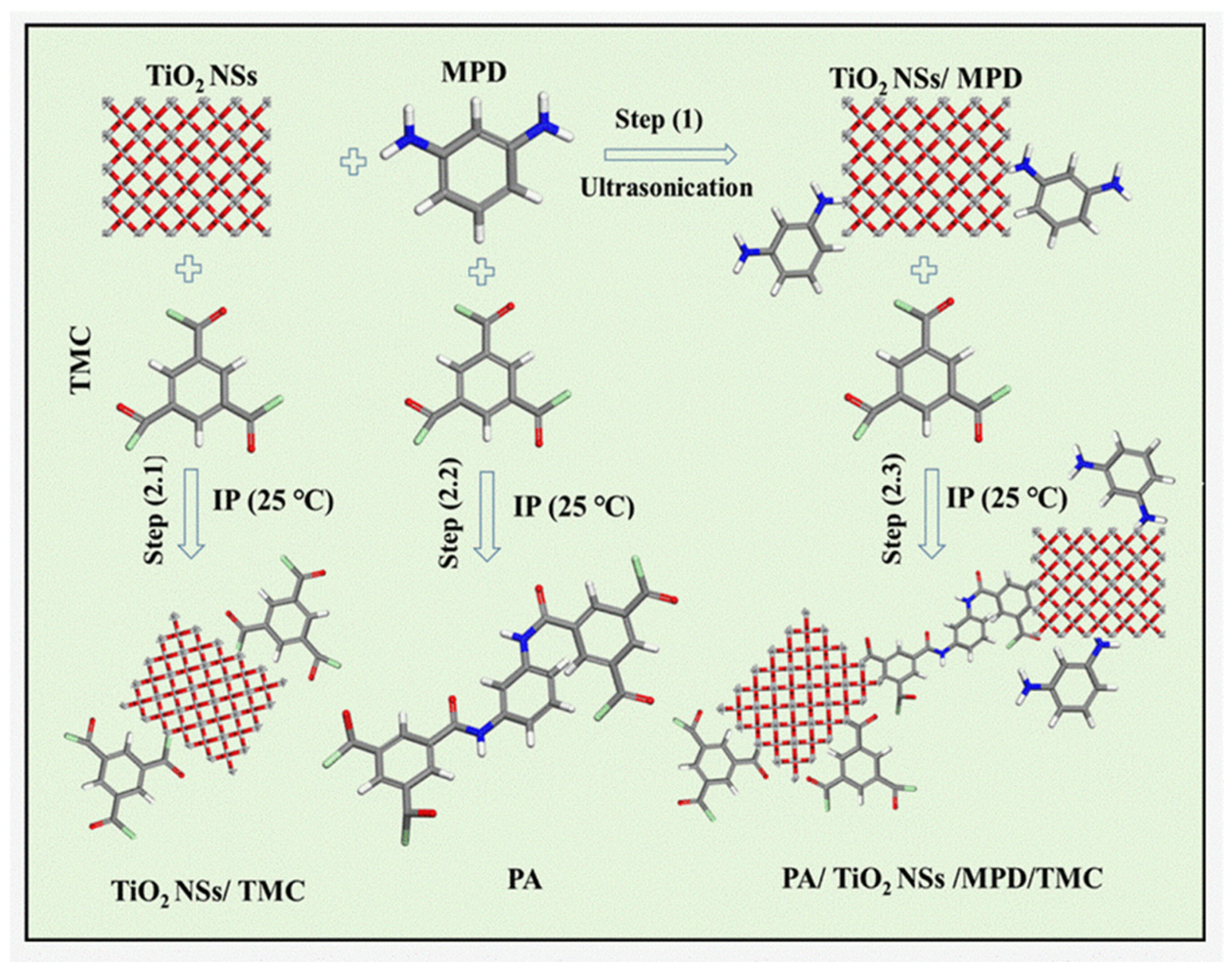

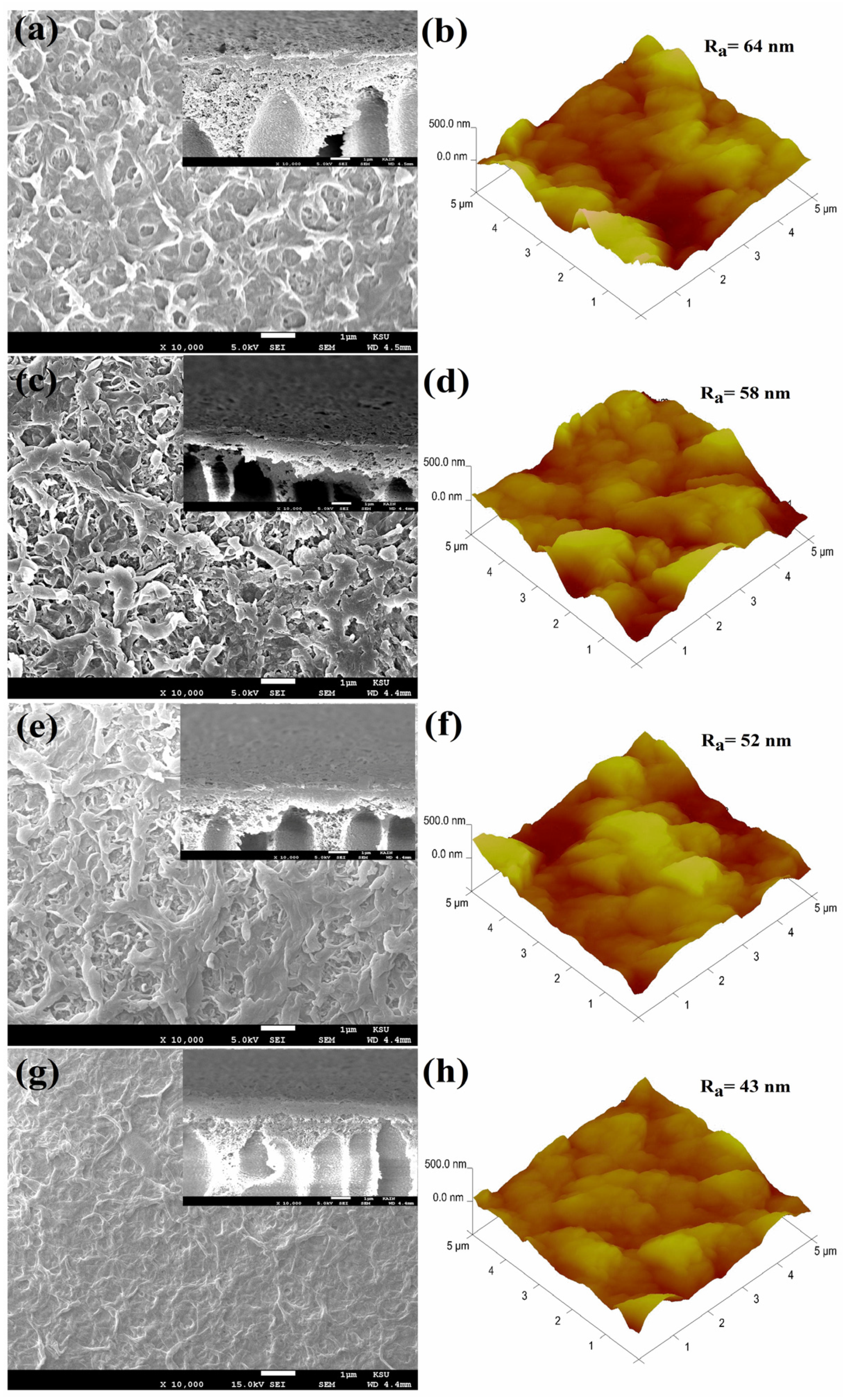
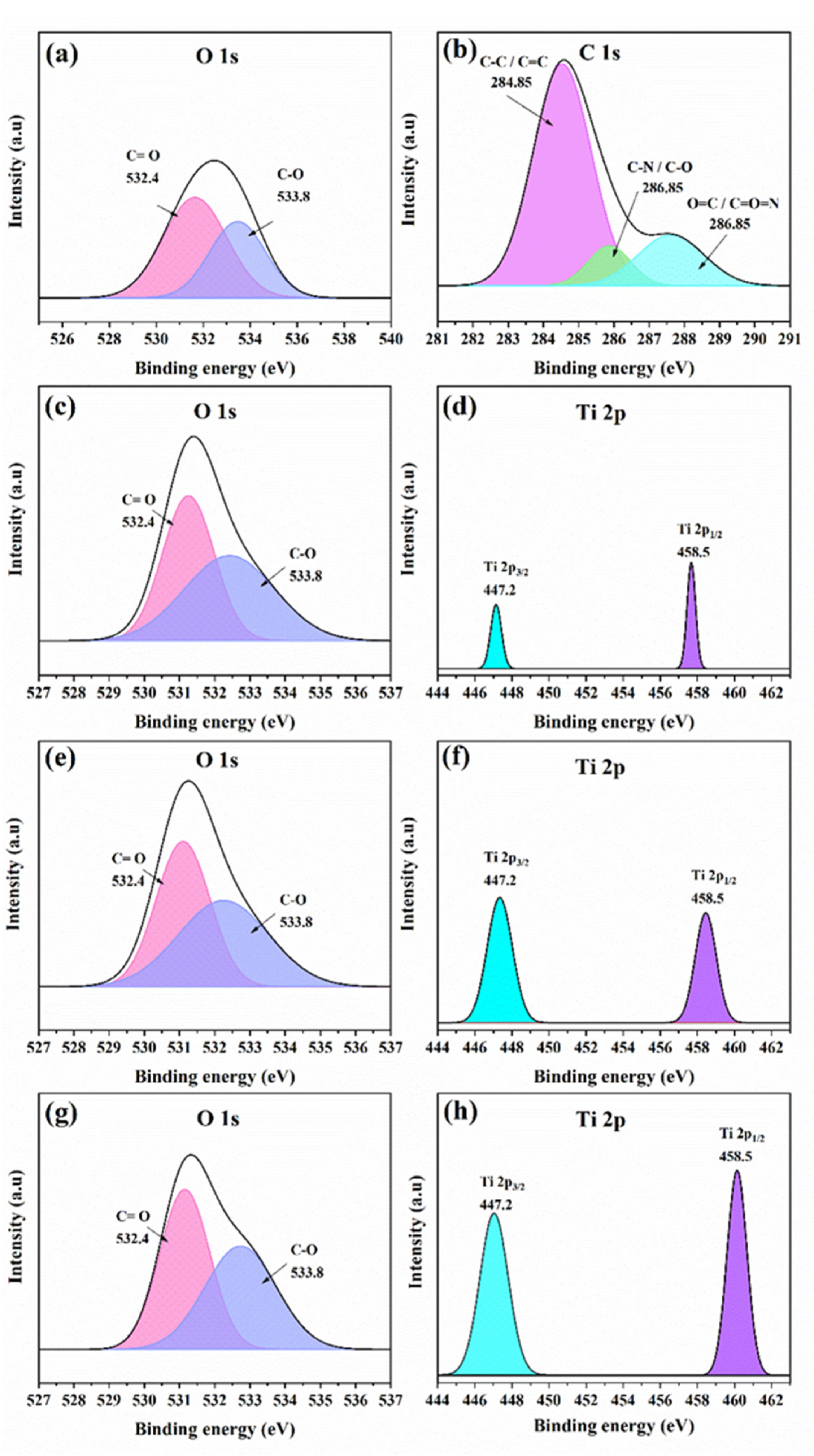
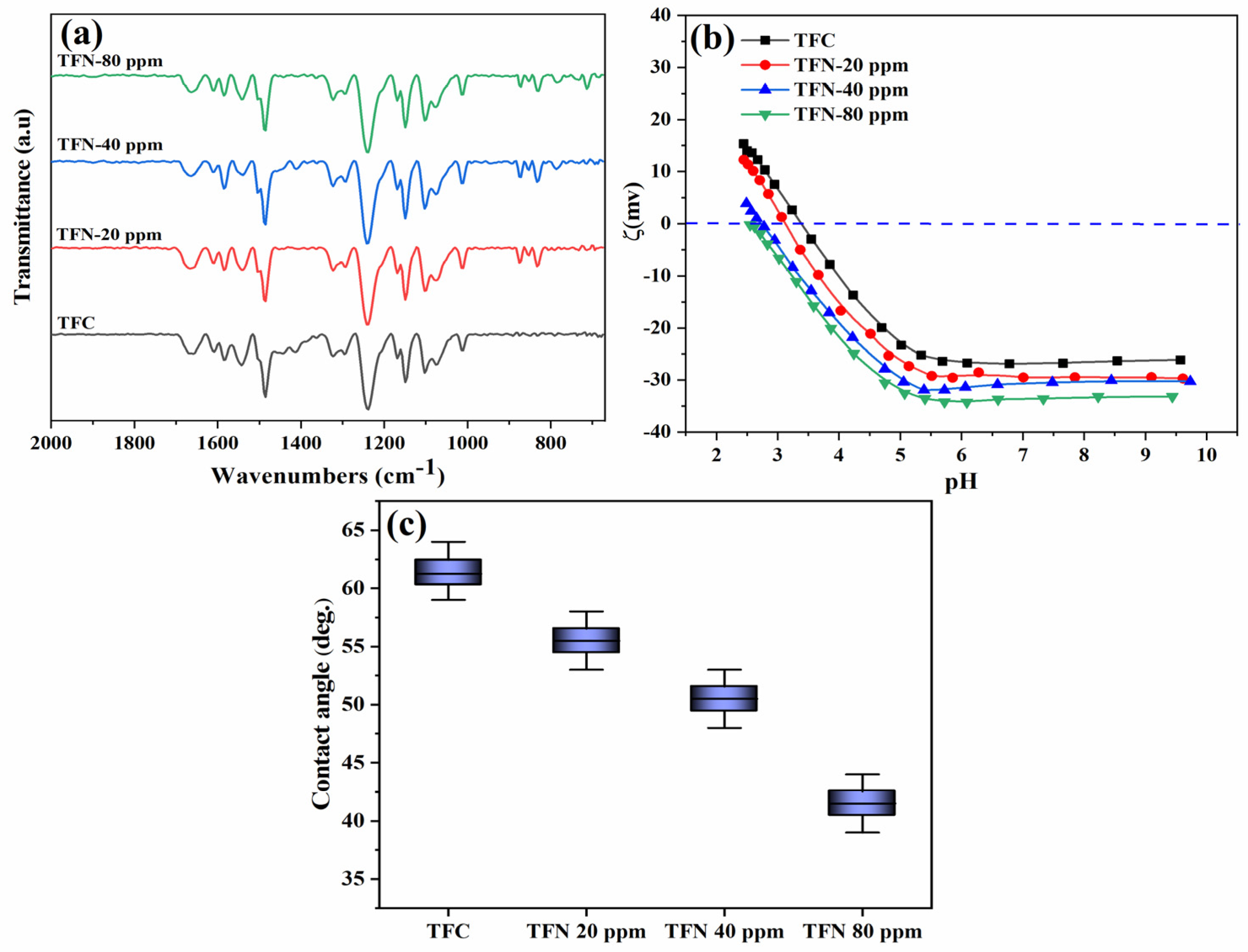
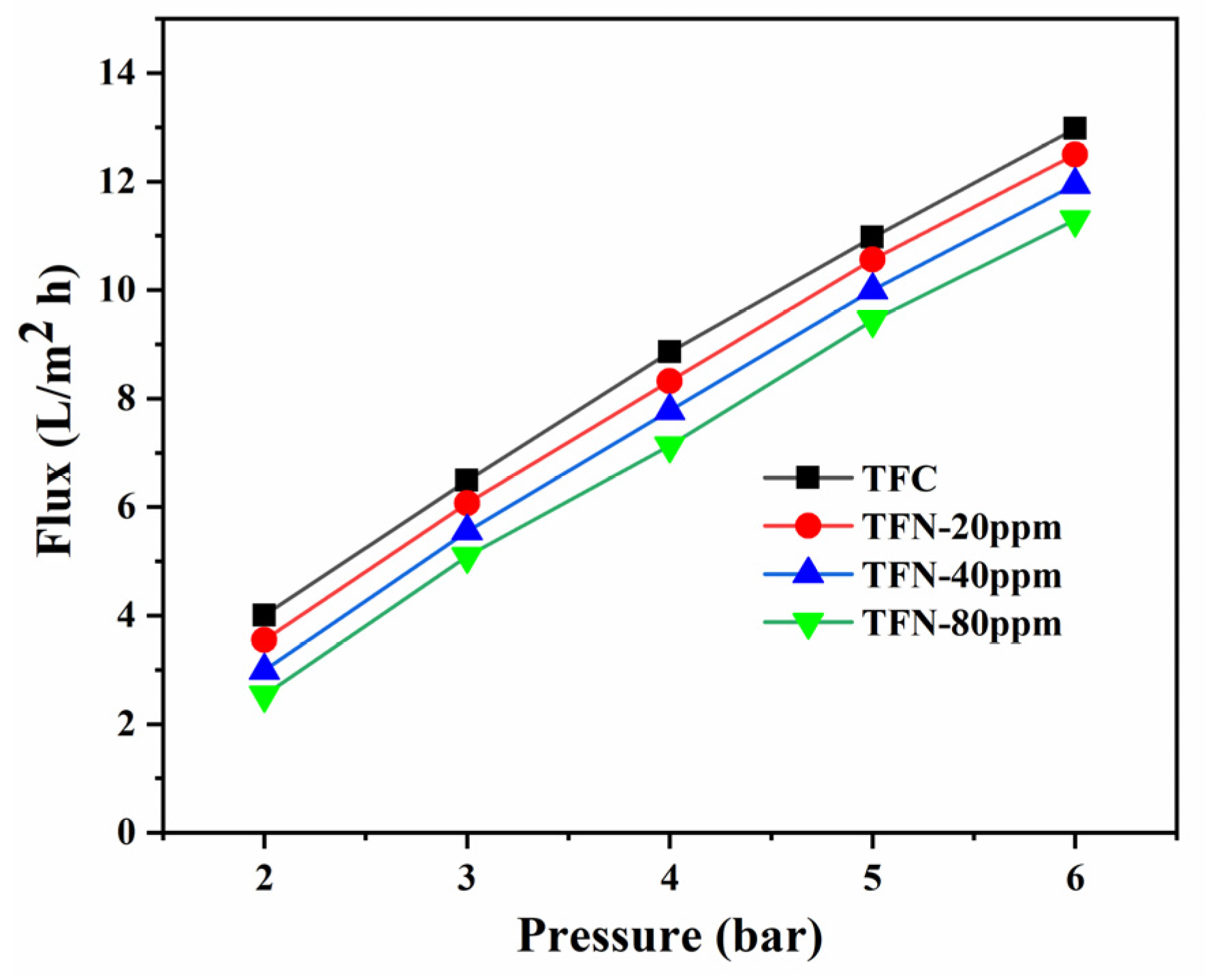
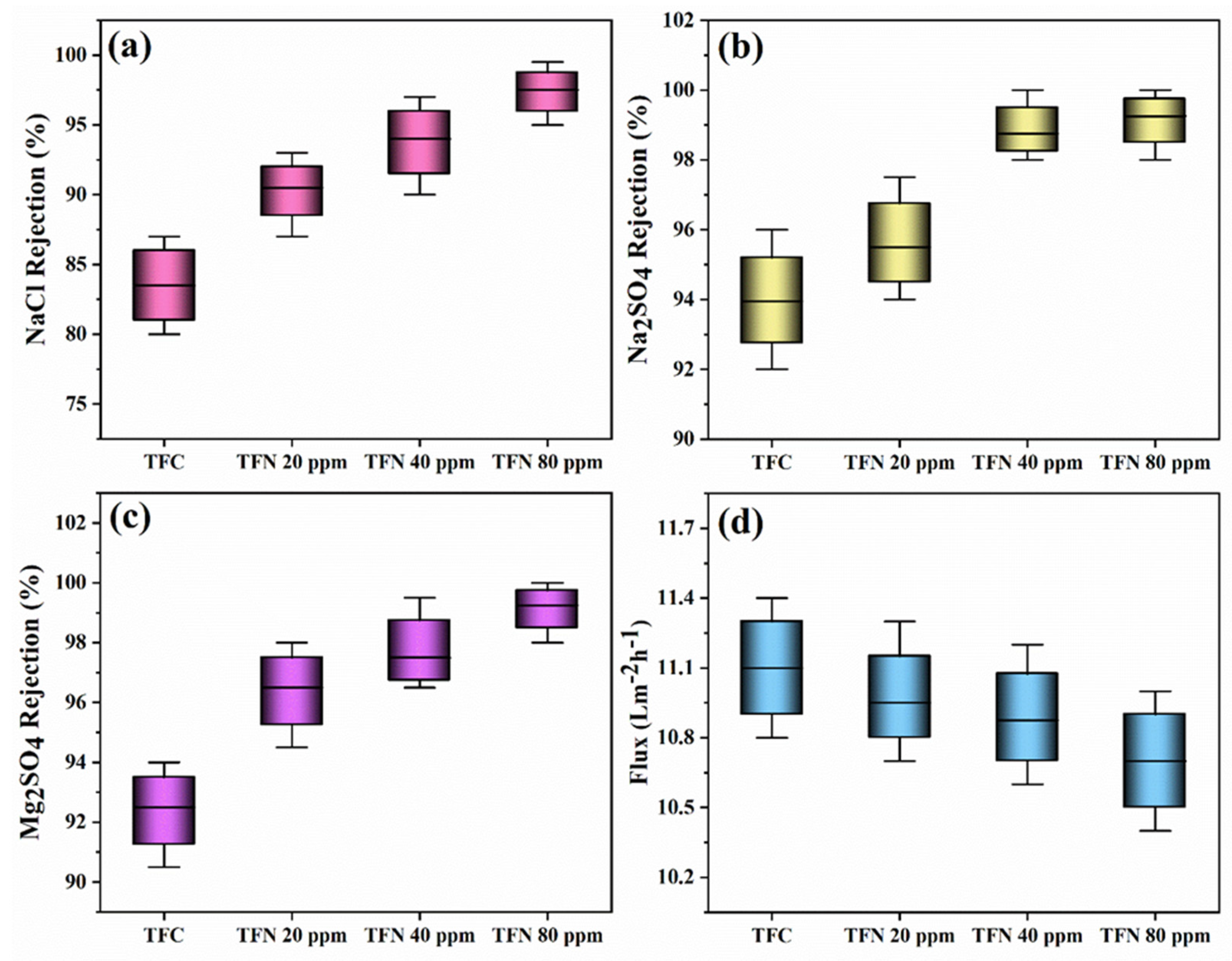

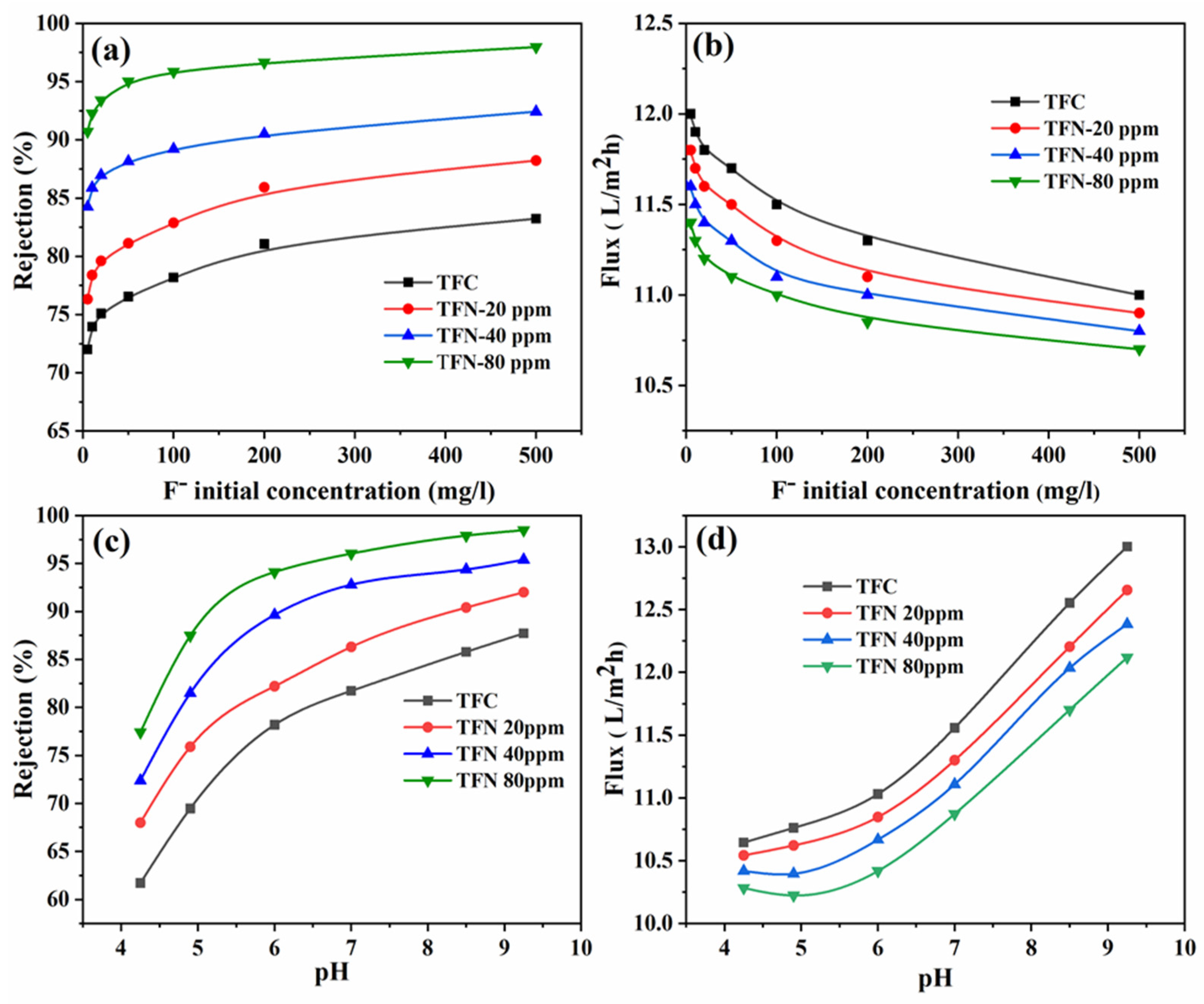

| Equations for the Donnan Steric Pore Model with the Dielectric Exclusion (DSPM-DE) | |
|---|---|
| Expanded Nernst–Planck equation: | |
| (3) | |
| (4) | |
| Potential gradient: | |
| (5) | |
| Donnan-steric partitioning: | |
| (6) | |
| Hindrance factor: | |
| (7) | |
| Steric partition coefficient: | |
| (8) | |
| Hindrance factor for diffusion: | |
| (9) | |
| (10) | |
| (11) | |
| Electro-neutrality condition: | |
| (12) | |
| Membrane charge density: | |
| (13) | |
| Membrane Type | Pressure (bar) | Flux LMH | Fluoride mg/L | Removal Efficiency (%) | Ref. |
|---|---|---|---|---|---|
| NF400 (PA) | 10 | ---- | 20 | 86.1 | [54] |
| Commercial BW30 (Dow FilmTech™, Dayton, OH, USA ) | 9.8 | 20 | 50 | 80 | [55] |
| BW30 (Dow FilmTech™, Dayton, OH, USA ) | 6 | 11.7 | 56.2 | >95 | [56] |
| NF270 (Dow FilmTech™, Dayton, OH, USA ) | 6 | 33.5 | 56.2 | 54 | [56] |
| NF90 (Dow FilmTech™, Dayton, OH, USA ) | 15 | 20.6 | 17.7 | 91 | [57] |
| BW30 | 10 | 19 | 212 | 90.6 | [58] |
| RO Spiral-wound TFC (Vontron, Guiyang, China) | 5 | ---- | 10 | 89.81 | [59] |
| NF/RO UTC-60 | 5 | 10.9 | 3 | 80 | [60] |
| RO membranes (BW30) | 10 | 19 | 239.9 | 90.8 | [61] |
| TiO2 NSs-incorporated PA TFN membrane | 5 | 10.6 | 500 | 98 | This work |
| TiO2 NSs-incorporated PA TFN membrane | 5 | 11.7 | 20 | 95 | This work |
Disclaimer/Publisher’s Note: The statements, opinions and data contained in all publications are solely those of the individual author(s) and contributor(s) and not of MDPI and/or the editor(s). MDPI and/or the editor(s) disclaim responsibility for any injury to people or property resulting from any ideas, methods, instructions or products referred to in the content. |
© 2024 by the authors. Licensee MDPI, Basel, Switzerland. This article is an open access article distributed under the terms and conditions of the Creative Commons Attribution (CC BY) license (https://creativecommons.org/licenses/by/4.0/).
Share and Cite
Ali, F.A.A.; Alam, J.; Qaid, S.M.H.; Shukla, A.K.; Al-Fatesh, A.S.; Alghamdi, A.M.; Fadhillah, F.; Osman, A.I.; Alhoshan, M. Fluoride Removal Using Nanofiltration-Ranged Polyamide Thin-Film Nanocomposite Membrane Incorporated Titanium Oxide Nanosheets. Nanomaterials 2024, 14, 731. https://doi.org/10.3390/nano14080731
Ali FAA, Alam J, Qaid SMH, Shukla AK, Al-Fatesh AS, Alghamdi AM, Fadhillah F, Osman AI, Alhoshan M. Fluoride Removal Using Nanofiltration-Ranged Polyamide Thin-Film Nanocomposite Membrane Incorporated Titanium Oxide Nanosheets. Nanomaterials. 2024; 14(8):731. https://doi.org/10.3390/nano14080731
Chicago/Turabian StyleAli, Fekri Abdulraqeb Ahmed, Javed Alam, Saif M. H. Qaid, Arun Kumar Shukla, Ahmed S. Al-Fatesh, Ahmad M. Alghamdi, Farid Fadhillah, Ahmed I. Osman, and Mansour Alhoshan. 2024. "Fluoride Removal Using Nanofiltration-Ranged Polyamide Thin-Film Nanocomposite Membrane Incorporated Titanium Oxide Nanosheets" Nanomaterials 14, no. 8: 731. https://doi.org/10.3390/nano14080731
APA StyleAli, F. A. A., Alam, J., Qaid, S. M. H., Shukla, A. K., Al-Fatesh, A. S., Alghamdi, A. M., Fadhillah, F., Osman, A. I., & Alhoshan, M. (2024). Fluoride Removal Using Nanofiltration-Ranged Polyamide Thin-Film Nanocomposite Membrane Incorporated Titanium Oxide Nanosheets. Nanomaterials, 14(8), 731. https://doi.org/10.3390/nano14080731










